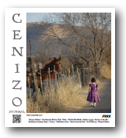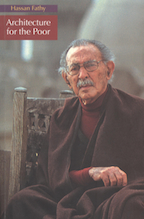
First published in Cenizo
Journal, winter 2013.
Click on the cover to download the PDF of that issue.
|
 I first spied it from a Jeep
on Casa Piedra Road:
a huddle of oddly shaped brown buildings baking in the sun. I'd
arrived at its modest gate after a mile and a bit of crunching
over gravel up from the Rio Grande near Presidio on the U.S.-Mexico
border. What interested me then—I was just starting my book
on far West Texas, focusing on the probable route of Alvar Nuñez
Cabeza de Vaca, the would-be conquistador of Florida who got
lost—was the landscape. Such raw, open vistas were easy
to imagine seeing through that ill-starred Spaniard's eyes. From
a cloudless dome, the February sun beat down on the rocks and
tangles of mesquite and clumps of prickly pear cactus, and ocotillo
that stretched on for what must have been, for anyone on foot,
a merciless number of miles. To the northwest loomed the bulk
of the Chinatis, to the east, the jagged and lavender Bofecillos,
and into Mexico, the Sierra Grande. I first spied it from a Jeep
on Casa Piedra Road:
a huddle of oddly shaped brown buildings baking in the sun. I'd
arrived at its modest gate after a mile and a bit of crunching
over gravel up from the Rio Grande near Presidio on the U.S.-Mexico
border. What interested me then—I was just starting my book
on far West Texas, focusing on the probable route of Alvar Nuñez
Cabeza de Vaca, the would-be conquistador of Florida who got
lost—was the landscape. Such raw, open vistas were easy
to imagine seeing through that ill-starred Spaniard's eyes. From
a cloudless dome, the February sun beat down on the rocks and
tangles of mesquite and clumps of prickly pear cactus, and ocotillo
that stretched on for what must have been, for anyone on foot,
a merciless number of miles. To the northwest loomed the bulk
of the Chinatis, to the east, the jagged and lavender Bofecillos,
and into Mexico, the Sierra Grande.
"That's Simone Swan's house."
My guide, Charlie Angell,
brought down the window to show me the object, until then mysterious
to me, of our detour. He'd been showing me the sights along the
Rio Grande— the Hoodoos, Closed Canyon, and the narrow shallows
in the river at Lajitas where Cabeza de Vaca, then nearly eight
years into his odyssey, may have waded across. Even today, in
many places along the river, you could walk right up to its bank,
pitch a stone, and it would thunk onto someone's alfalfa field
in Mexico. Coming up Casa Piedra Road, we'd seen no one—just
a flash of a jackrabbit. Already Charlie was making the U-turn
back to Presidio.
"It's Egyptian," he added.
This, in a land of décor inspired by what I had come to
think of as Ye Olde Cowboys & Indians, struck me like thunder.
Well, was it like the inside of a Disneyland ride? Did she worship
Isis? Once home, I Googled.
Simone Swan, it turned out, is an adobe visionary with a distinguished
career in the arts, including many years with Houston's Menil
Foundation; her house, not Egyptian, exactly, nor a whim, but
a work-in-progress used by her Adobe
Alliance, a nonprofit for teaching earthen design and construction.
And the  Egyptian
influence? Hassan Fathy. Egyptian
influence? Hassan Fathy.
Not Fathy as in "Cathy," as an Egyptian acquaintance
was quick to correct me, but Foh'tee.
Another Google search bought up his book, published by the University
of Chicago Press in translation from the French, Construir
avec le peuple, as Architecture
for the Poor. When I got my hands on a copy, I learned
that Fathy was Egypt's greatest 20th century architect, renowned
for rescuing ancient architectural features and techniques for
building with mud brick, a material he passionately advocated
for as abundant, and, when used appropriately, comfortable, ecological,
sanitary, and beautiful.
...
In his photo, he
might have passed for an elderly Mexican lawyer with his halo
of gray hair, mustache, red turtleneck and poncho-like burnouse.
He squinted from behind his glasses in an expression at once
pained and kind—entirely understable once I learned of his
battles with the Egyptian bureaucracy, then enamored of Soviet-style
steel and concrete housing, and his nonetheless unyielding commitment
to building housing for and with the fellaheen, the peasants
who lived in abject poverty.
Born in 1900 into a wealthy family in Alexandria, Fathy did not
set foot on one of his own family's many farms until he was in
his twenties, and when he did, the wretchedness of its workers'
houses shocked him. His solution, in part, was to build with
better design and mud brick. Mud could be dug up easily, bricks
could formed of the mud, animal dung, and a bit of straw, and
then left to bake in the sun. The challenge was the cost of timber
for roofing and, for brick vaults, timber for propping them up
during construction. Egypt imported its timber from Europe. Then
World War II broke out.
Ancient Egyptians built vaults, many of which had survived for
hundreds, even thousands of years, without using wood, but how?
Every one of Fathy's attempts to construct a roof without wood
collapsed in a heap of bricks and dust. But then his brother,
who was working on the Aswan dam, mentioned that the Nubians,
the dark-skinned people of Southern Egypt and Northern Sudan,
roofed their houses and mosques without using wood.
In an a matter of two visits to Aswan, Hassan Fathy found the
masons, barefoot and in turbans, who showed him their technique
of roofing by means of parabola-shaped layers of adobe bricks
laid at an angle against a back wall. The bricks had extra straw
for lightness, and a groove, made by the scrape of a finger before
they'd dried, on one side, so as to give the mortared brick "grab."
Mortar was a mix of sand, clay, and water. Using no tools other
than an adze, and a plank for scaffolding, two men threw up a
fine mud-brick roof over a 10' x 13' room in one and a half days.
Marveled Fathy, "It was so unbelievably simple."
When Simone
Swan was living in New York, a house with two courtyards
came to her in a dream. And it seemed like a dream to me that,
less than a year after I'd first glimpsed Swan House from the
road, I was sitting with its owner in the Nubian vault that was
the living room, the shell high above us aglow with the orange
light of morning. A graceful eighty-something with a crown of
snow-white hair, Simone Swan was telling me how, at mid-life
in the 1970s, she had gone to Paris for the Menil Foundation's
exihibition of the surrealist Max Ernst's paintings, and at a
dinner party, met a filmmaker who had just wrapped a documentary
on the world's greatest architect.
Simone laughed. "I said, Hassan Who?"
Intrigued, the next morning, she bought his book, which she read
in her native French. It changed her life.
She had been considering going to architecture school, but inspired
by the aesthetic and social vision of Architecture for the
Poor, she wrote to its author. Fathy answered in his own
hand, "I open my country and my heart to you."
Soon Swan found herself in the shadow of Cairo's Citadel, ensconsed
in the guest-room of his Mamluk-Ottoman house. She worked on
his archive (later taken over by the Aga
Kahn Foundation). "When I would pull a book out from
the shelves, a cloud of dust would fall on me! Frankly, I thought
I was mainly going to write about him. I had no idea that I would
become a designer-builder."
Swan House, named in honor of her mother and built in 1997, has
the form of an H, the great hall, "an exalting space, like
in Italy," as Simone described it, with its 16 foot-high
flat truss-roof, connecting four wings: kitchen and living room;
master bedroom and guest bedroom, each a Nubian vault. So there
were, as she'd seen in the dream, two courtyards, one open to
the sunset, the other to the sunrise, in turn providing relief
from the harshness of the northern Chihuahuan Desert's sun and
wind.
As part of her workshop, Simone had given us students a tour
that also included the domed guest-house, two sheds, and then,
from the western courtyard, a clamber up the outside stairs to
the flat-roof with its latticed parapet above the great hall.
Always, everywhere, from the narrow doors and tiny windows, and
especially here, from the flat-roof: that jaw-dropping view.
To to east, a hawk disappeared into the maw of the arroyo. South,
on the Mexican side of the river, rose the igneous monolith of
the Sierra del Diablo where, as the Indians recalled decades
later, Cabeza de Vaca had planted a crucifix.
"How could I resist when I saw this?" Simone said.
"I was seduced!"
She'd come to the Big Bend as a guest of her friend from New
York, the artist Donald
Judd. While driving in from Houston, she visited Presidio's
adobe Fort
Leaton, then undergoing renovation. Welcomed as a volunteer,
upon her return from New York, she rented a room in Presidio,
put on overalls, and set to making mud bricks, giving talks,
and building a Nubian vault. Here on the US-Mexico border, in
a climate similar to Egypt's and where she perceived an acute
need for more affordable, ecological, and attractive housing,
she determined to stay, committed to adobe, to "show people
what they could do themselves."
In the three days of the workshop, we shoveled clay and sand
through a seive and mix mortar in a wheelbarrow. We met Jesusita
Jiménez, an expert mason who had worked on almost every
aspect of the house. We talked about Dennis Dollen's monograph,
Simone
Swan: Adobe Building; and of course, Hassan Fathy.
On a brisk walk across the desert, Simone told me about her childhood
on a coffee plantation in the Belgian Congo when "elephants
would appear in the jungle." Over coffee in the kitchen,
she recounted the successes and travails with Swan House and
the local communities on both sides of the border. From the east
patio, we watched a full-moon rise as thin as a watermark, then
a wafer, then, floating in a sea of stars, a marble. Midmorning,
doves came to drink from a pan.
On a windy afternoon, cold enough to want gloves, balancing on
the top of a ladder, I lay bricks in the parabolic arch of another
Nubian vault—this one for an office. I hacked up a cactus
to macerate in a bucket of water for the plaster. A carload of
us skipped over the border to make abode bricks in a maestro's
dirt yard surrounded, ironically, by cinderblocks. And each time
we returned to Swan House, indeed with each hour, it seemed to
emanate, like a living thing, charming Sphinx, a subtly different
quality of feeling. The walls changed colors, sometimes rosy,
sometimes a honey-gray; bright straw-speckled brown; slate. And
inside, as one of the participants, architect Paul
Dennehy put it, "It is as if the small openings allow
only the most beautiful light inside—always pleasing; always
just right."
. |
 Listen to C.M. Mayo read this essay for
PEN San Miguel, plus Q & A. Listen to C.M. Mayo read this essay for
PEN San Miguel, plus Q & A. |
|
Your comments are
always welcome. |
|
|

|
|






